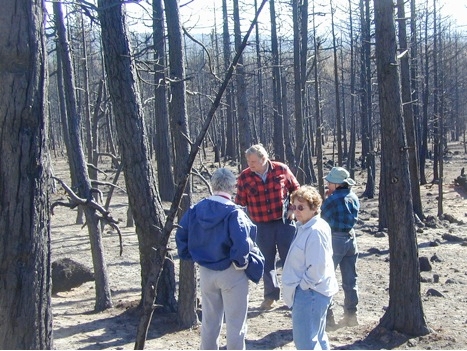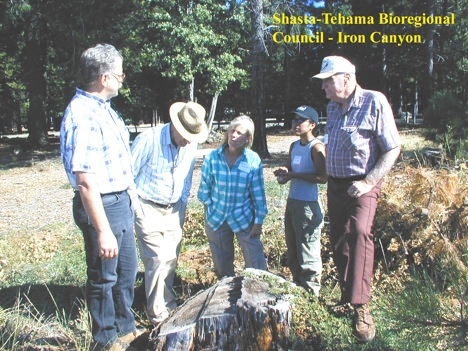
Precursors to community-based forestry efforts and groups have been bioregional councils, watershed groups, and fire safe councils. Bioregional councils were formed in the early 1990s in response to the Northwest Forest Plan (to restore the Northern Spotted Owl); watershed groups have formed to conduct watershed restoration projects; fire safe councils to conduct fuels treatments to reduce wildfire hazard. Often these specific issue (biodiversity, water, fire) community groups expand into more comprehensive, landscape scale community-based forestry groups when it becomes apparent that you cannot effectively or sustainably protect biodiversity, restore a watercourse or reduce fire hazard without taking other factors into consideration than just your specific interest or concern. E.g. fuel treatments may reduce fire hazard, but can also affect plant biodiversity and create soil erosion problems. Some balance must be struck.
The Quincy Library Group (QLG) is perhaps the earliest and best known community-based forestry effort in California. http://www.qlg.org/pub/contents/overview.htm Established in 1993, the QLG began the discussion of community-based forestry, the debate over (local) communities of place which represent a wide range of interests, and (national) communities of interest (Sierra Club, timber interests) which are more narrowly focused. The QLG recognized very early that landscape-scale fuel treatments needed to be implemented at a rapid pace and large-scale to be effective in addressing the increasing fuel hazard.
The 2000 Secure Rural Schools and Community Self-determination Act provided for the establishment of county Resource Advisory Committees (RACs) to recommend federal grant funding for projects which benefit the local national forest. E.g. Many RACs in California recommended grants for fuel reduction treatments in the forest to reduce catastrophic wildfire risk. The RACs are comprised of local community members representing elected officials, industry (forest products, mining), recreation (OHV, hiking), environmental groups, native Americans, and the general, unaffiliated public. Over time, RAC members, and thus the community, have come to better understand and appreciate the Forest Service and National Forests, an important outcome of the RACs. https://fsplaces.fs.fed.us/fsfiles/unit/wo/secure_rural_schools.nsf
The Shasta County RAC has come to see community-based forestry as the legacy of the RAC process, pro-actively encouraging large-scale, community-based projects. In 2010, the Shasta RAC recommended funding of a landscape scale, community-based forest restoration effort called the Burney-Hat Creek Forest Restoration Project, because it promises to restore an important wetland area, produce jobs in the local community (timber, biomass energy), develop OHV and campground areas, and to do so in a collaborative, ecologically and socially/politically sustainable manner. It is a project that the Shasta RAC hopes becomes a template for the Forest Service’s public involvement in planning regular program projects.
The Omnibus Public Land Management Act of 2009 established the Collaborative Forest Landscape Restoration Program (CFLRP) to select and fund ecological restoration projects for priority forest landscapes. This is a formal codification of community-based forestry goals of community involvement in national forest management, collaborative processes for project development and implementation, projects that benefit local economies with employment and training, and an “all lands” approach to restoration that encompasses public and private forests with due recognition of property rights and responsibilities. http://www.fs.fed.us/restoration/CFLR/index.shtml
In 2010, the Dinkey Landscape Restoration Project on the Sierra National Forest received a CFLRP grant. http://www.fs.fed.us/restoration/CFLR/documents/2010Proposals/Region5/Sierra/Sierra_NF_CFLRP_Proposal.pdf
“Community forests” take community-based forestry one step beyond being merely advisory to the Forest Service/BLM in that the local community develops memoranda of understanding, stewardship contracts or other formal agreements with the public landowner to assume responsibility for the management of the land and resources. Webinar presentations on Community Forests in California can be seen at http://ucanr.org/community_forests
The Forestland Steward newsletter, Winter 2011, is devoted to “New directions in Community-based Forestry.” http://www.ceres.ca.gov/foreststeward/pdf/news-winter11.pdf
Attached Images:
